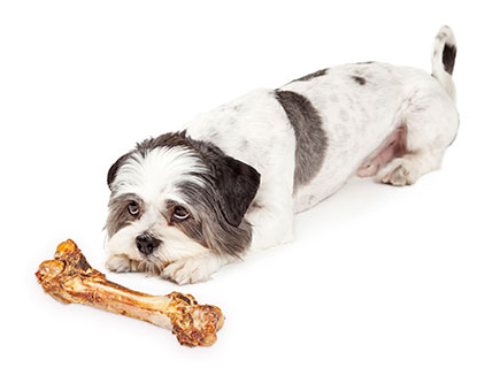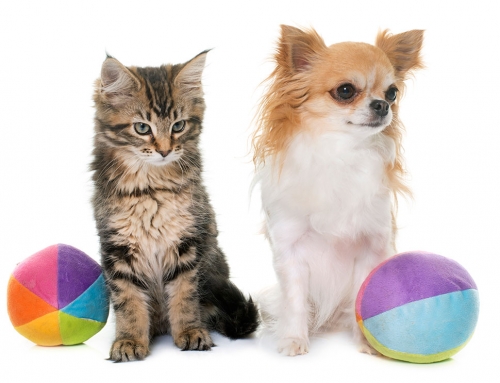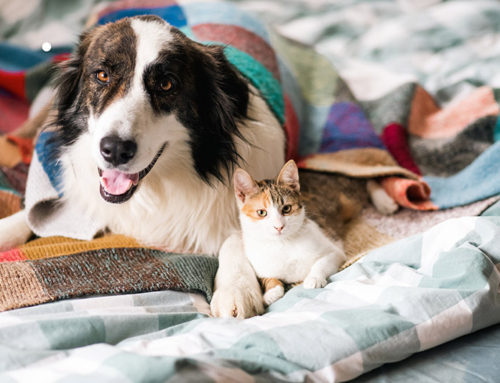What Brand to Feed
Proper nutrition is vital to your pet’s health. With so many different pet foods available, how do you know which one to choose? Fortunately, there are numerous high-quality brands on the market today, and as a responsible pet owner you need to understand nutrition so you can pick the optimal diet for your pet. Your pet needs you to provide a healthy diet. Overnutrition or undernutrition can damage your pet’s health. Learning which brand is right for your pet takes a little effort on your part. It’s important to choose a brand that suits your pet’s metabolism, lifestyle, and taste buds. Keep in mind that there is no one brand that is superior to all others, but do stay away from cheap brands with fancy labels!
Homemade Diets
Just like humans, cats and dogs have complex nutritional requirements to stay healthy. Although the concept of cooking for your pet may be enticing, at this time I don’t recommend homemade diets unless instructed by your veterinarian. There are numerous problems with cooking for your pets. First, formulating your own cat or dog food is a difficult task. It’s time-consuming and much more expensive to try and produce quality foods that provide better nutrition than you’d get from a premium brand of cat or dog food. Second, the nutrients in the formulation may not be the right quantities or proportions that your pet needs. Incorrect preparation and cooking may also deplete certain nutrients and result in a deficient diet. Third, homemade diets haven’t been tested to document performance in cats and dogs over long periods of time. With so many excellent commercial brands available, I don’t see any benefit to homemade diets right now.
Nutrition 101
Remember, you are what you eat and your pet is what you feed it. Understanding the nutritional needs of your cat or dog is vital to selecting the optimum pet food to meet its daily needs. By understanding the basics of nutrition, you’ll not only extend your pet’s life, but decrease your vet bills as well.
Unlike most foods made for humans, pet food products are manufactured to be the only source of nutrients for a dog or cat. To survive, dogs and cats (just like humans) need the six basic nutrients: water; protein; fats; carbohydrates and fiber; vitamins; and minerals. These nutrients must be provided together in certain proportions to be most effective in the diet.
I can recall so many stories of well-intentioned pet owners who misfed their pets, causing horrible results. If these six nutrients are not completely balanced in the diet, your cat or dog can become malnourished and develop serious health problems.
1. Water
Water is the most important nutrient, as it accounts for 50% to 60% of an adult dog or cat, with greater than a 15% loss resulting in death. Water is necessary for:
- Most biochemical reactions in the body
- Helping regulate body temperature
- Lubricating tissue
- Important component of blood
2. Protein
Proteins are made up of amino acids and are the building blocks for cells, tissue, organs, enzymes, hormones, and antibodies. Proteins are essential for:
- Muscle growth
- Tissue repair
- Energy
Dogs and cats can manufacture some amino acids within their bodies, but the rest, called essential amino acids, must be gotten from their food. These essential amino acids are arginine, methionine, histidine, phenylalanine, isoleucine, threonine, leucine, tryptophan, lysine, valine, and for cats only, taurine.
Sources of protein
- Meat: Chicken, lamb, turkey, beef, and some fish supply animal-based proteins and have complete amino acid profiles.
- Egg: Regarded as the quality standard for protein sources, it also has complete amino acids.
- Vegetable/cereal protein: The quality of protein will vary with the type, age, and conditions under which the plant was grown. Note that these proteins are deficient in some essential amino acids and are considered incomplete proteins.
- Soy: Like vegetables, soy is also an incomplete protein.
3. Fats
Fats are a concentrated form of energy. In addition, fats are needed for:
- Healthy skin and coat
- Hormone production
- Absorption of fat-soluble vitamins
- Insulation
Essential fatty acids, like linoleic acid, must be provided in the diet. Additionally, arachidonic acid is an essential fatty acid only for cats. It’s important for maintenance of the skin and coat, and for kidney function.
4. Carbohydrates and Fiber
Carbohydrates and fiber are necessary for the following reasons:
- Used for a source of energy
- Provide bulk for muscle contraction of the gastrointestinal tract to move food material through the gut
- Some fibers promote the right mix of bacteria in the small intestines to keep it healthy
5. Vitamins
Vitamins are organic compounds that are necessary for a wide range of metabolic activities. Because most vitamins can’t be synthesized, dogs and cats require them in their diet, but in low concentrations. These vitamins are A, D, E, K, thiamin (B1), pyridoxine (B6), cobalamin (B12), riboflavin (B2), niacin (B3), pantothenic acid, and folic acid. Vitamins are important for:
- Chemical reactions
- Normal metabolic functions
Vitamin deficiencies/excesses are not uncommon and can lead to a wide range of clinical abnormalities such as impaired vision, anorexia, weight loss, skin disorders, bone abnormalities, muscle twitching, neurological abnormalities, and weakness.
6. Minerals
Twelve minerals are known to be essential nutrients for dogs and cats. These minerals are calcium, phosphorus, magnesium, sodium, potassium, chlorine, iron, copper, zinc, manganese, selenium, and iodine. Minerals are inorganic compounds that are not metabolized and yield no energy. These nutrients, like vitamins, can’t be synthesized by animals and must be provided in the diet. Minerals are used for:
- Components of bone and teeth
- Maintaining fluid balance
- Involvement in many metabolic reactions
Your cat or dog can’t master these principles, so learning about nutrition will help you feed your pet properly. This will increase your pet’s health and vitality throughout their life, and in return, they’ll reward you with many years of wet kisses and fewer bills from the vet.
Pet Food Regulations
The Association of American Feed Control Officials (AAFCO) is the regulatory group that establishes guidelines and definitions for all animal feeds, and includes members of the industry, research community, government, and academia. AAFCO sets recommended levels of protein, carbohydrates, fats, minerals, and vitamins, but enforcing adherence to AAFCO guidelines is left to individual state governments. This means that compliance can vary widely. AAFCO publishes these regulations for nutritional adequacy of complete and balanced dog and cat foods. Companies with nationwide distribution will likely offer higher-quality products because national distributors will have to produce products that can comply with the strictest regulations in the country, no matter where they end up being sold.
Not all pet foods have been fed directly to dogs and cats. There are three ways that a pet food can obtain an AAFCO stamp of approval. First is by chemical analysis, second is by the manufacturer determining mathematically, on paper, what the nutrient profile would be, and third is by feeding trials. With chemical analysis or mathematical calculations, the product isn’t actually fed to dogs or cats.
The third—and my preferred—method of testing, via AAFCO standardized feeding trials, is far superior in indicating how well the nutrients in that particular pet food will be assimilated. Here, the specific food is given to eight dogs or cats for 26 weeks. These animals are then assessed as to how healthy they are and how well the nutrients were utilized and/or absorbed. If this method of testing is used, it will appear on the label.
How to Read Labels
Learning to read labels will teach you a great deal about the food you’re feeding your cat or dog. You can also call the phone number on the bag or can, or go to the website for information. This way the company can offer explanations of what’s listed on the label. It’s important to know that one company’s product may be very different from another’s.
Pet food labels are strictly regulated by AAFCO, the federal government, the Food and Drug Administration, and the Department of Agriculture, and must follow strict guidelines like human food labels.
If the pet food follows the guidelines set forth by AAFCO, the label will include a statement that says the food provides complete and balanced nutrition for that life stage, and it will also list whether the food is intended as a treat or a supplement.
Higher-quality diets with excellent protein sources cost more, but cheap ingredients are less efficiently digested. Your pets have to eat more of them to meet their nutritional needs, if that is even possible. This translates into higher costs and, you guessed it, more poop to scoop.
PET FOOD LABELS
Labels are usually divided into two separate sections:
- The principal product display
- This should include the product name, brand name, weight, and intended species.
- Information about the food
- Ingredient list: This must be in descending order of weight, meaning that the first ingredient listed is the one with the greatest volume in the food.
- Guaranteed analysis: This lists the amounts of each ingredient contained in the food, although this is usually the minimum amount listed and not always the exact amount.
- Feeding instructions: This gives guidelines as to how much of the food is to be fed per day.
- Nutritional adequacy claims: This lists the life stage for which the food is made.
Things You Want on the Label
- Look for a pet food that conforms to minimal AAFCO standards.
- Choose a pet food that has a highly digestible source of protein. Meat-based diets such as chicken, turkey, beef, or fish are much better because the protein is of higher quality and easier to digest. Look closely because many foods are vegetable-based, like soybean, corn, or rice, all of which contain incomplete proteins.
- The first two or three ingredients on the label should be some type of animal protein such as chicken, beef, fish, lamb or turkey. They should not be animal by-products (the leftover part of the meat), grains, or vegetables.
- The pet food can or bag should have an expiration date. Don’t feed foods past their expiration date.
- There should be a phone number and/or website so you can contact the company and ask questions.
- Look for natural preservatives like vitamin C or E.
Things to Avoid
- Generic-label or store-label brands. Feeding cheap food to your pet is the equivalent of people eating fast food. It’s cheap and it tastes good, but it’s not good for you. It’s much better to eat a well-balanced meal with high-quality ingredients like lean meats, vegetables, and fruits.
- Purchasing food past its expiration date.
- Food that has preservatives that are controversial. These include BHT, ethoxyquine, BHA, and propylene glycol.
- Unidentified meat, bone meal, or meat by-products listed on the label.
- Vegetables or grains listed as the first several ingredients.
- Cheap foods with fancy labels





